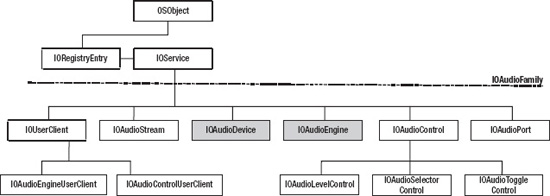I/O Kit Audio Support
The IOAudioFamily handles audio in the kernel and facilitates the creation of drivers for audio hardware. The responsibility of an audio driver is conceptually very simple; it merely transfers data to and from the hardware on behalf of clients (much like any hardware driver). It is also responsible for performing actions like muting, controlling the volume, or other configurable attributes. Core Audio uses 32-bit floating-point format as its native audio format and because not all devices will support this, a driver must handle conversion to and from a format the hardware is able to handle. Figure 12-3 shows the hierarchy of classes that make up the IOAudioFamily.

Figure 12-3. IOAudioFamily classes
Let's have a look at the role of each class in the family.
- The
IOAudioDeviceclass serves as a central coordination point for an audio driver. It is responsible for attaching to a hardware provider and configuring and initializing the hardware. The class itself is not usually directly involved in the I/O of audio, which instead is the role ofIOAudioEngine. TheIOAudioDeviceclass also centralizes timing and synchronization services. - The
IOAudioEnginerepresents the DMA or I/O engine of an audio driver. Because an audio device can have many inputs and outputs that operate independently, it makes sense to encapsulate their behavior into their own class. If you look at the I/O Registry entries for the Apple built-in audio device on a Mac Pro, you will see the Apple audio driver has five instances ofIOAudioEnginerepresenting Line input, S/PDIF optical input, Headphone output, Line output, and S/PDIF optical output. AnIOAudioEnginemust allocate at least oneIOAudioStream. TheIOAudioEngineis an abstract class. - The
IOAudioStreamrepresents a sample buffer. A sample buffer has a direction associated with it, which can be either input or output. It also has metadata that describes the formats it is capable of supporting, such as the numeric format of the contained samples, the sample rate, and the number of channels supported. The class is not abstract and can be instantiated directly. The class does not allocate memory for the sample buffer itself. It has to be told the location of the buffer. It is responsible for exposing the sample buffer to user space consumers. The audio stream also maintains an internal mix buffer where audio from multiple sources is mixed together into a single stream. - The IOAudioControl class represents a tunable parameter of the device, such as the input volume, output volume, and mute. The
IOAudioControlclass is directly usable, but you can also subclass it yourself to create custom controls. Three subclasses ofIOAudioControlexist,IOAudioLevelControl,IOAudioSelectorControl, andIOAudioToggleControl. A control may belong to the device itself, the engine, or anIOAudioPort. IOAudioPortcan be used to represent a logical or physical port, such as Line out or Headphone out. The use of this class is not required for an audio driver.- The Core Audio framework communicates with an
IOAudioEnginethrough theIOAudioEngineUserClient, which allows it to interact with the engine's sample buffers for the purpose of playing back or capturing audio. - The
IOAudioControlUserClientserves as a user client forIOAudioControlinstances and allows manipulation. This is how an application, such as System Preferences, can control volume or mute.
